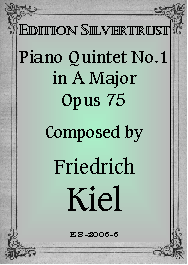Presents
Friedrich Kiel
|
|
|
Piano Quintet No.1 in A Major, Op.75
 Friedrich
Kiel's two piano quintets are as fine as any written in the 19th
century--including those of Brahms and Dvorak. They are magnificent works and it
is unpardonable that they are not known and have not taken a place in the
standard repertoire for this combination. We are very pleased to make these
outstanding works available to the public once again.
Friedrich
Kiel's two piano quintets are as fine as any written in the 19th
century--including those of Brahms and Dvorak. They are magnificent works and it
is unpardonable that they are not known and have not taken a place in the
standard repertoire for this combination. We are very pleased to make these
outstanding works available to the public once again.
Writing of the chamber music of Friedrich Kiel (1821-1885), Wilhelm Altmann—perhaps the greatest of chamber music critics—notes that it was Kiel’s extreme modesty which kept him and his exceptional works from receiving the consideration they deserved. And what consideration did Altmann feel these works deserved? After mentioning Brahms and others, Altmann writes, “He produced a number of chamber works, which...need fear no comparison.” Altmann, himself, said that he found in Kiel’s chamber music a “never ending source of delight.” That his works remained relatively unknown was due mostly to his modesty but also, Altmann explains, to the high cost of the original editions. We agree with Herr Altmann: To play and hear Friedrich Kiel’s chamber music is a wonderful experience.
Kiel was taught the rudiments of music and received his first piano lessons from his father but was in large part self-taught. Something of a prodigy, he played the piano almost without instruction at the age of six, and by his thirteenth year he had composed much music. Kiel eventually came to the attention of Prince Wittgenstein, a great music lover. Through the Prince's efforts, Kiel was allowed to study violin with the concertmaster of the Prince’s fine orchestra with which he later performed as a soloist. Kiel was also given theory lessons from the renowned flautist Kaspar Kummer. By 1840, the eighteen year old Kiel was court conductor and the music teacher to the prince’s children. Two years later, Spohr heard him and arranged for a scholarship which allowed Kiel to study in Berlin with the renowned theorist and teacher Siefried Dehn. In Berlin, Kiel eventually became sought after as an instructor. In 1866, he received a teaching position at the prestigious Stern Conservatory, where he taught composition and was elevated to a professorship three years later. In 1870 he joined the faculty of the newly founded Hochschule für Musik which was shortly thereafter considered one of the finest music schools in Germany. Among his many students were Noskowski, Paderewski and Stanford. Kiel's hobby was mountaineering and at age 60--two years before his tragic death as the result of a traffic accident--he climbed Europe's second highest peak, Monte Rosa.
Kiel's First Piano Quintet, in five movements, dates from 1873-4. It is a large genial affair full of wonderful melodies and original ideas and effects. The first movement, Allegro moderato ma con spirito, opens in the lower voices with distant echoes of Mendelssohn. The rich and darkly hued development section has writing as fine as Brahms' best. The second movement though marked Allegro molto, is a deliberate and moderate tempo intermezzo with a gorgeous interplay of strings and piano. The highly romantic third movement, Adagio con espressione, is a movement of modest length no doubt because Kiel recognized the aura created by the intense beauty of the melody would be dissipated if it continued on too long. At this point, Kiel inserts an extra movement, Tempo di Menuetto, which shows him thinking almost along the older serenade type works of more than four movements. As the minuet begins, it is entrusted entirely to the piano playing solo. (Our soundbite begins when the entire ensemble takes over) . It has a calm, veiled quality to it. The superb and exciting finale, Allegro, bubbles over with a fecundity of melody. The sure touch of a master composer is everywhere in evidence.
Parts: $39.95